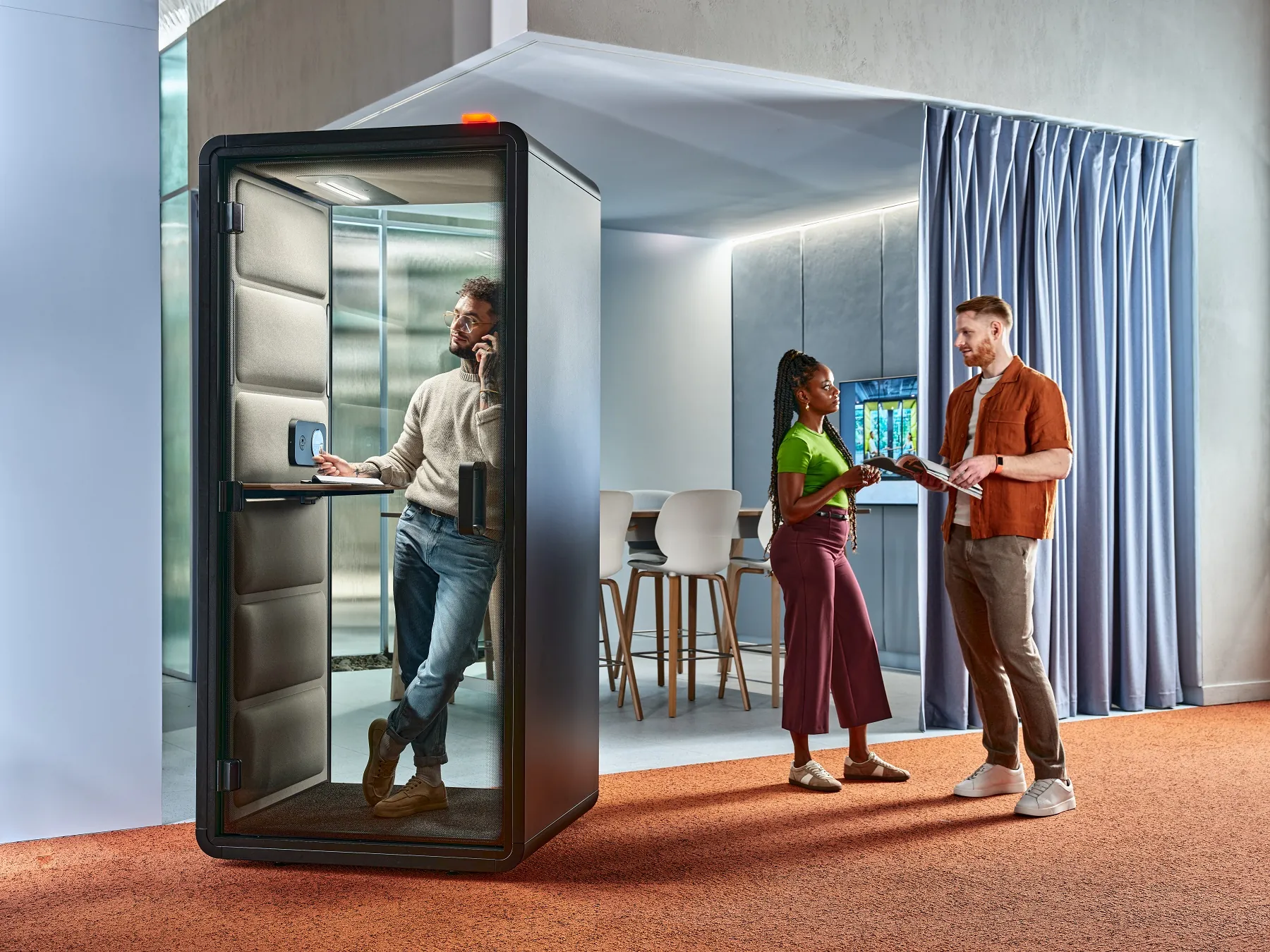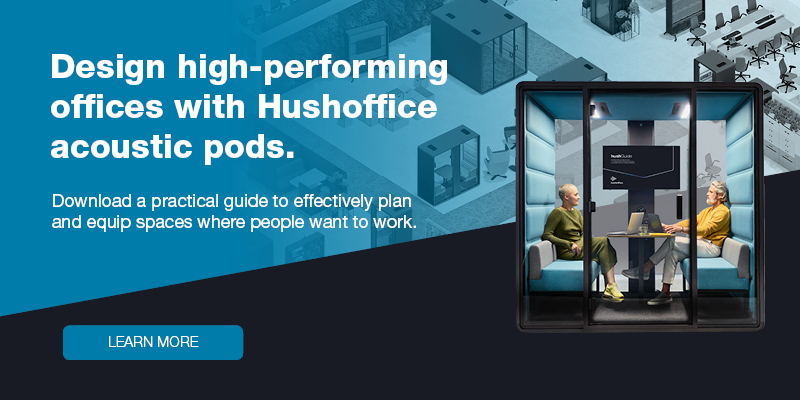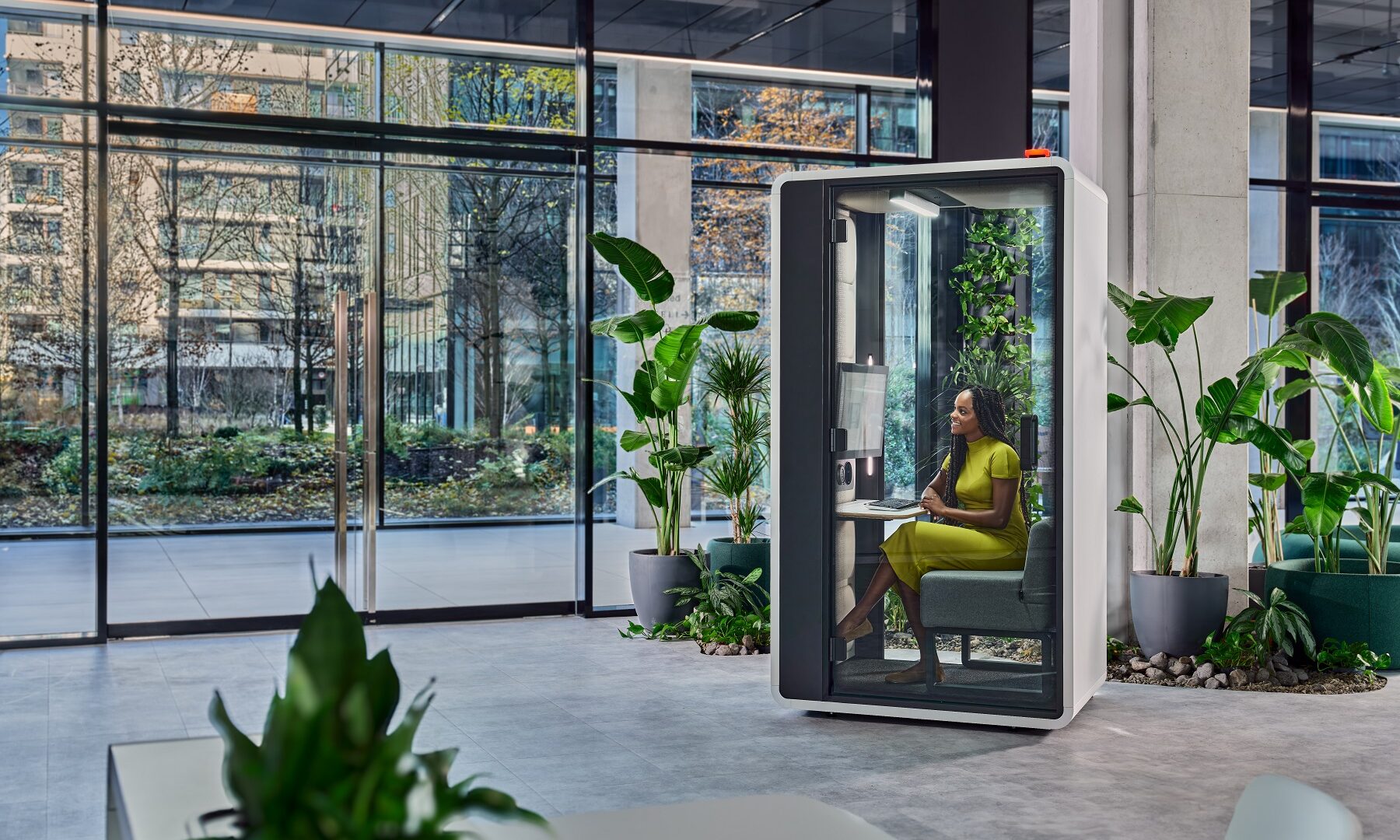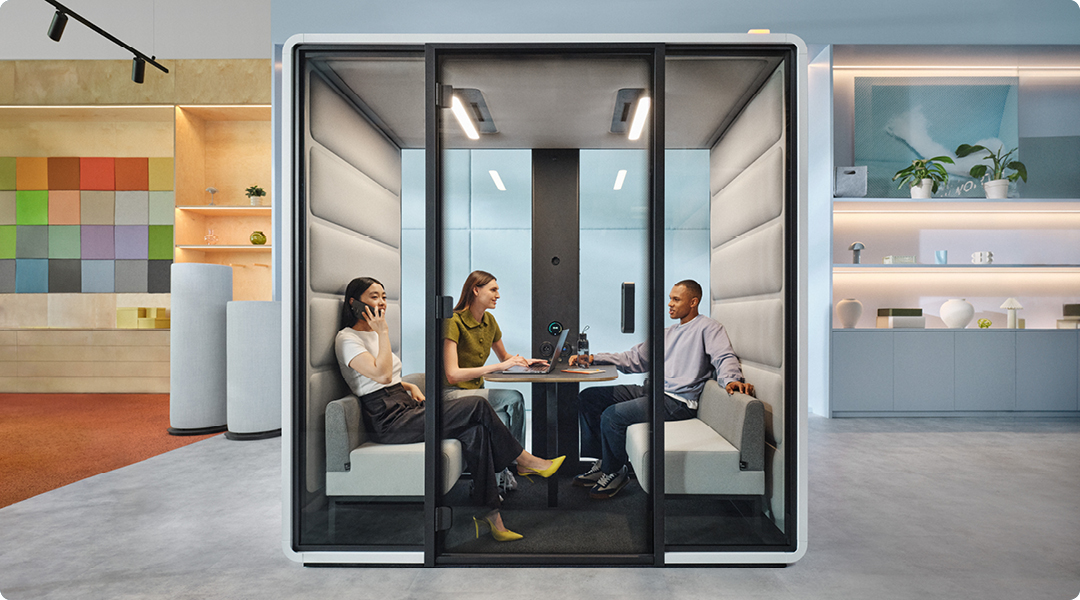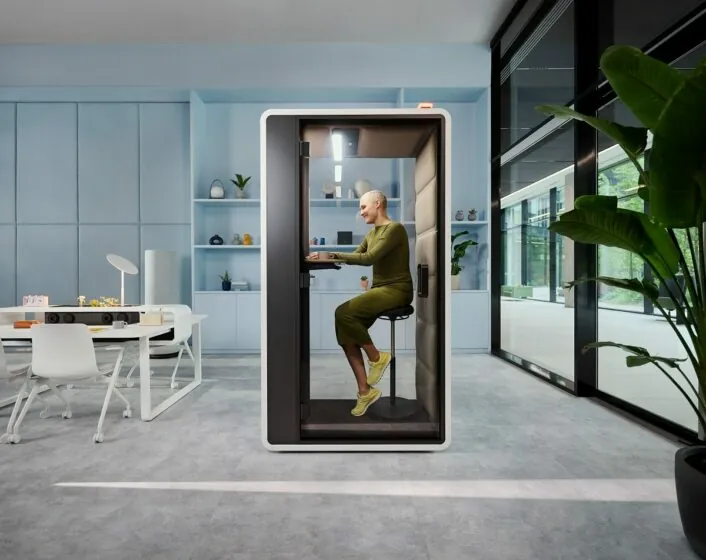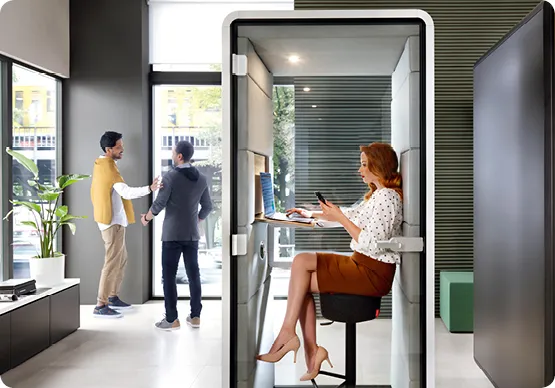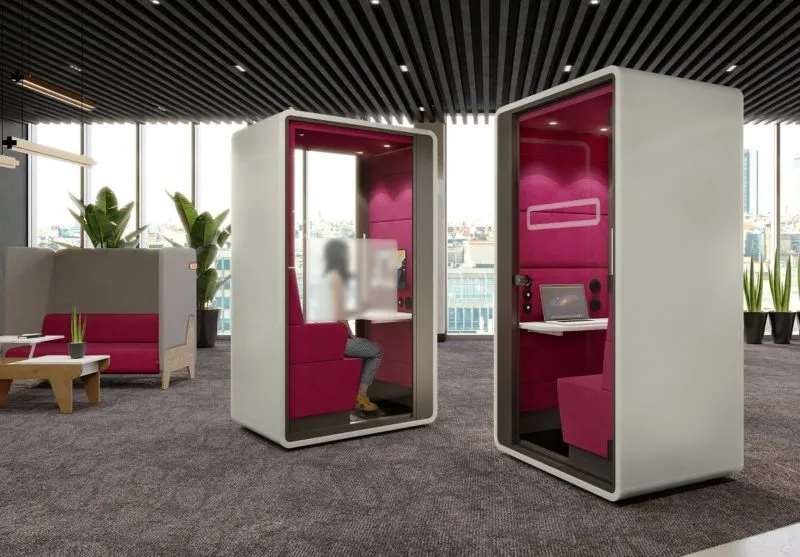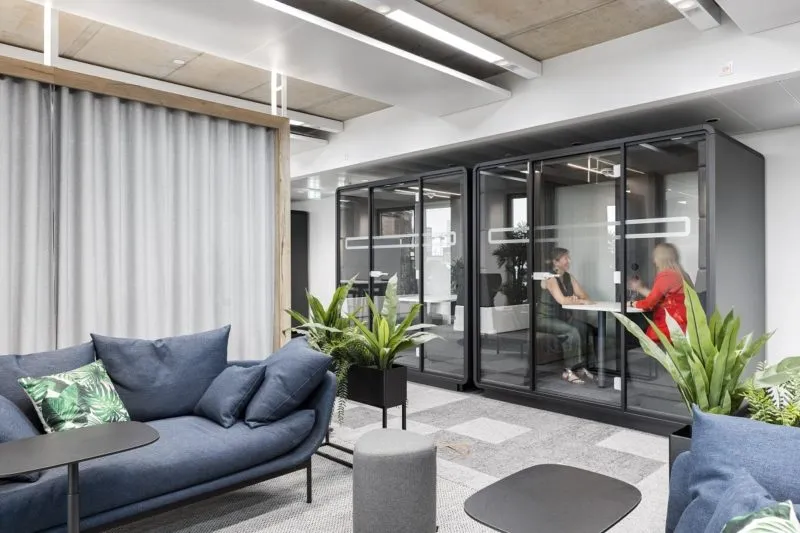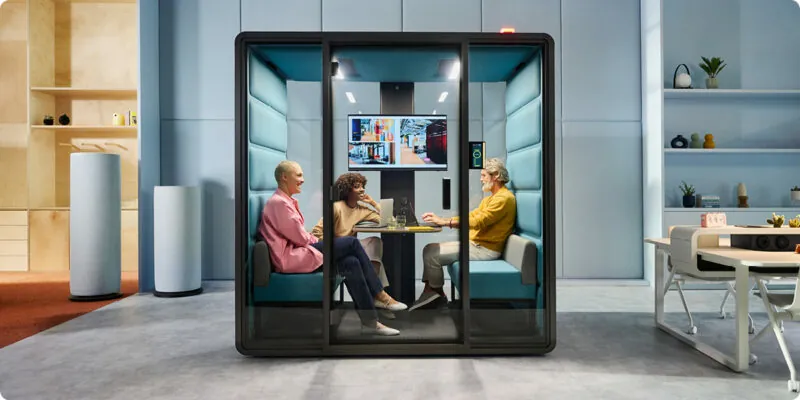Neuroarchitecture. How office design shapes the brain.
- Posted on: 13 June 2025
- By: Hushoffice Team
An office isn’t just a container for work — it’s an active system influencing how we feel and think. Neuroarchitecture encourages us to use neuroscience as a lens to look at the workspace, turning design elements like sound, light, and layout into tools supporting performance and well-being. HushFree pods exemplify this, offering spaces designed with the mind in mind.
Neuroarchitecture – tl;dr
- Our brains respond constantly to their surroundings — from lighting and soundscapes to furniture placement and air quality. Every design detail is processed neurologically, either helping or hindering our ability to relax, focus or innovate. Neuroarchitecture applies brain science to the built environment, revealing how smart design can support mental clarity and emotional balance.
- Workplace wellbeing goes far beyond perks or HR policies. Elements such as daylight, sound privacy, colour schemes, and the inclusion of nature are not just decorative — they act on the nervous system. Treated as sensory interventions, these design cues can influence how we feel and how well we work.
- Solutions such as hushFree booths reflect the principles of neuroarchitecture. They offer calming, enclosed spaces that reduce sensory overload while giving people control over their environment. These pods meet a fundamental neurological need for refuge and agency, with knock-on effects for wellbeing and productivity.
Does your office energise — or overstimulate?
Every element in a workspace acts on the brain. An overstimulating setting — harsh lighting, noise, clutter — keeps us in a state of heightened alert. This drains mental reserves. In contrast, a thoughtfully designed area such as a quiet, sound-isolating call booth supports mental clarity and calm focus.
The layout of office space deeply affects creativity and concentration.
We don’t just use space; we interpret it. The brain takes subtle cues from layout and form. Space isn’t ever neutral – a small, boxed-in room may trigger vigilance, while a bright, airy space suggests openness.
Why sunlight makes a measurable difference.
Office workers exposed to daylight have better sleep quality and health overall. It keeps the circadian rhythm in sync, promoting wakefulness during the day and better rest at night. The effect on mood and mental clarity is both physiological and intuitive.
What kind of soundscape supports focus?
Different people have widely different noise and sound preferences. That’s why flexible acoustic solutions such as hushFree.S are so useful — they allow individuals to step in and out of silence on their own terms. For many, this kind of control is essential for deep work and audio privacy.
Can space influence emotional wellbeing?
It absolutely can! Elements like lighting, acoustics, and visual openness engage the limbic system, governing mood and emotion. Poor sensory input leads to tension; positive input supports resilience. Calm spaces reduce cortisol, helping people feel emotionally grounded.
Neuroarchitecture. What is it?
This field combines neuroscience with design thinking. It’s about creating spaces that actively support mental processes. It brings architecture together with psychology and neuroscience to create spaces that support attention, emotion, creativity, even memory.
Neuroarchitecture doesn’t start with what looks good — it begins with what the brain requires: security, engagement, restoration. In an office, this means reducing chaos and supporting comfort. Booths and pods are a direct expression of this approach. They’re compact, calming, and lit intuitively. They meet the mind where it’s at, offering the calm we seek and the privacy we rarely get. A seated hushFree.S.Hybrid booth for one, for instance, becomes a zone of full cognitive control — where you decide how much stimulation you allow in
– explains Hushoffice Principal Brand Manager, Mateusz Barczyk.
What effect does neuroarchitecture have on brain function?
Neuroarchitecture leverages how the brain is sensitive to its environment — including the lighting, textures and, materials — to cue creativity and focus. This is effective because of how the brain responds deeply to its surroundings, continuously watching for signs of novelty, safety, or efficiency.
Which design factors influence wellbeing most strongly?
The built environment constantly interacts with the nervous system. Shape, brightness, noise — each one produces physiological effects. When coordinated well, they work together to keep us alert yet calm, productive yet relaxed.
Why background noise disrupts concentration.
Ambient sound interferes with the brain’s attention systems. It is disruptive to how the prefrontal cortex regulates focus. Over time, this “noise stress” takes its toll on output and wellbeing.
For team discussions requiring privacy, mid-size booths such as hushFree.M offer a sweet spot. They pull groups out of the ambient noise without creating disconnection. These pods provide a breathable kind of silence — not absolute quiet, but enough to keep dialogue flowing without disruption. Their acoustic design makes conversation effortless without feeling cut off from the wider space
– says Hushoffice Principal Brand Manager, Mateusz Barczyk.
The hidden strain of being constantly visible
When employees feel they’re being watched at all times — the so-called “fishbowl” effect — it can cause mild social anxiety. Over time, this raises cortisol and narrows creativity. That’s why quiet, semi-private nooks are essential in open offices.
Natural light fights mental fatigue.
Sunlight does more than light the room — it resets neural rhythms. By aligning internal clocks, it helps keep the brain sharp and regulated throughout the day.
How can one design an office for maximum daylight?
Placing desks near windows, using surfaces that reflect light, and putting the outdoors in sightlines all help. Glass features and skylights further increase brightness, distributing natural light more evenly and reducing the need for artificial lighting.
Artificial lighting is more than just visibility.
Light doesn’t merely brighten a room — it acts as a biological signal, influencing hormones, sleep and decision-making. In places where using daylight isn’t possible, lighting that mimics its natural rhythm is the ideal substitute.
Can brightness levels really shift how we work?
Absolutely. Brighter, cooler-toned lighting tends to sharpen alertness and focus. In contrast, softer, warmer light supports creativity and abstract thinking — making each suitable for different types of work.
Lighting control via hushAssistant: custom comfort in every booth.
Adjustable lighting isn’t a luxury — it’s a productivity tool. hushAssistant, the simple interface within every hushFree pod, lets users fine-tune brightness and warmth to suit their task. Booths like the accessible hushFree.Access.M make this available to all — physical and sensory comfort included.
Colour psychology: how tones and hues shape emotions.
Colour can resonate emotionally and unconsciously. Certain hues energise, others calm. Neuroarchitectural design ingeniously makes use of this knowledge. Colour becomes an atmospheric cue, helping shape how a room feels and functions.
What colours create the right work atmosphere?
Greens and blues tend to be soothing and promote calm and stability. Yellows and oranges add a dose of energy and optimism, ideal for creativity.
Does adding greenery really help?
Science says it does. Even brief exposure to plants has been shown to lower blood pressure as well as stress hormones like adrenaline and cortisol. In environments with a lot of pressure, greenery acts as a visual pause — tiny moments of nature that aid recovery.
How to introduce nature to the workspace?
Biophilic design isn’t just about potted plants. Natural materials, flowing forms, and organic textures all contribute. A patch of moss or timber accent wall in a hushFree.Access.L pod can transform the feel of a meeting space.
Why unmanaged noise is productivity’s enemy?
Background noise disrupts thinking, breaking focus and forcing the brain to filter constantly. In offices with little sound control, mental energy is drained before real work begins. Pods like hushFree restore clarity by shielding the brain from this sensory overload.
Supporting different noise sensitivities through smart design…
Everyone experiences sound differently. Using different zones helps — team spaces like larger booths for four to six, smaller ones for two for private thought. Combine these with acoustic panels, sound buffers, or white noise systems to offer auditory comfort for all.
How acoustic pods improve work comfort?
In still, quiet spaces, the brain has permission to relax. That’s when top-quality work happens. Pods allow speech to stay private and thoughts to stay uninterrupted — a recipe for deep productivity.
Encouraging movement as part of cognitive health.
The hippocampus — the centre for memory in the brain — thrives on physical movement. Layouts that prompt walking, casual meetings, and spatial change help the brain stay adaptable and responsive.
Movement is the finishing touch in a brain-friendly workspace. We have our five senses, yes — but how we travel through space matters just as much. The most neurologically supportive offices are those that invite movement. The optimal way to enable that is to offer a range of work zones: a sit-down booth such as hushFree.S.Hybrid to support sustained focus… a standing pod like hushFree.XS for calls or short tasks… a sit-stand model such as hushFree.S to provide ergonomic variety. When spaces nudge us to change posture, location, or setting throughout the day, the brain stays switched on
– says Hushoffice Principal Brand Manager, Mateusz Barczyk.
Neuroarchitecture – summarized
- Our brains respond constantly to their surroundings — from lighting and soundscapes to furniture placement and air quality. Every design detail is processed neurologically, either helping or hindering our ability to relax, focus or innovate. Neuroarchitecture applies brain science to the built environment, revealing how smart design can support mental clarity and emotional balance.
- Workplace wellbeing goes far beyond perks or HR policies. Elements such as daylight, sound privacy, colour schemes, and the inclusion of nature are not just decorative — they act on the nervous system. Treated as sensory interventions, these design cues can influence how we feel and how well we work.
- Solutions such as hushFree booths reflect the principles of neuroarchitecture. They offer calming, enclosed spaces that reduce sensory overload while giving people control over their environment. These pods meet a fundamental neurological need for refuge and agency, with knock-on effects for wellbeing and productivity.
Neuroarchitecture – FAQ
Is neuroarchitecture just for newly built offices?
Not at all. It’s just as useful for intentional retrofits and upgrades. Even small changes — shifting desks to improve daylight access, adding acoustic booths, or integrating more plant life at important points — can yield measurable mental health and focus benefits. All without having to overhaul the office.
Can workplace design affect how well teams interact?
It absolutely can. Space sends social signals. Welcoming layouts with gentle acoustics help build trust and openness. On the other hand, noisy, cramped areas may lead to tension or withdrawal. Design doesn’t just influence how people work — it shapes how they connect.
Why does personal control over one’s work setting matter?
The brain thrives on both predictability and agency. Being able to manage your surroundings — through lighting, sound, or privacy — reduces stress and improves cognitive stability. Pods like hushFree deliver exactly this: the gift of a pocket of autonomy in a shared, busy world.
